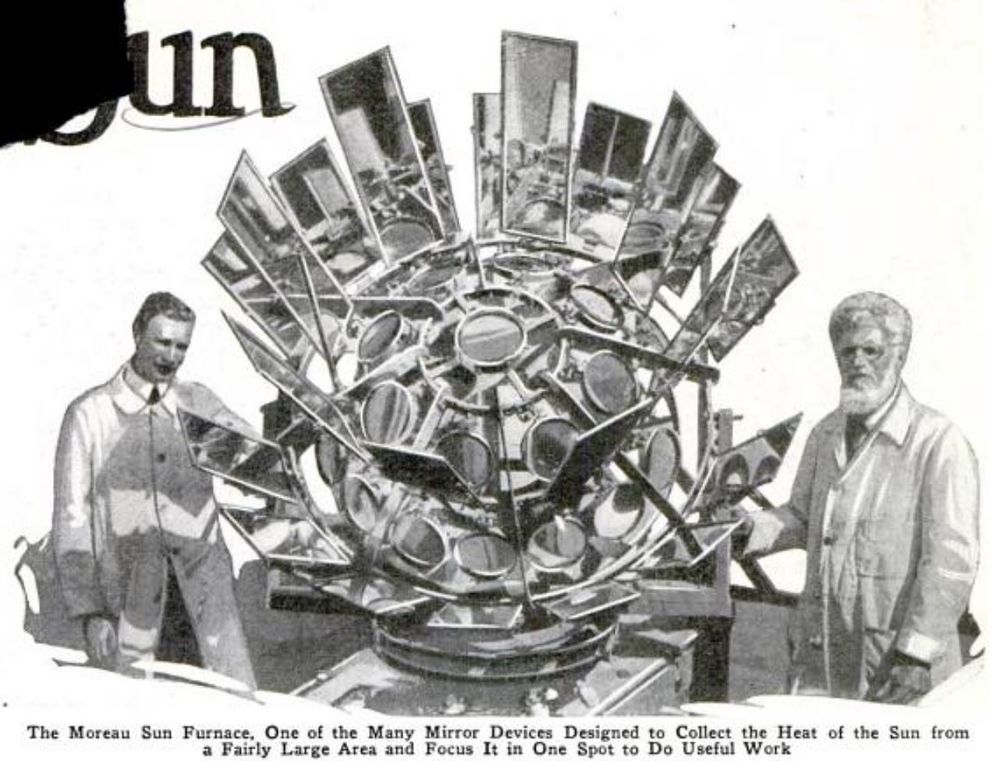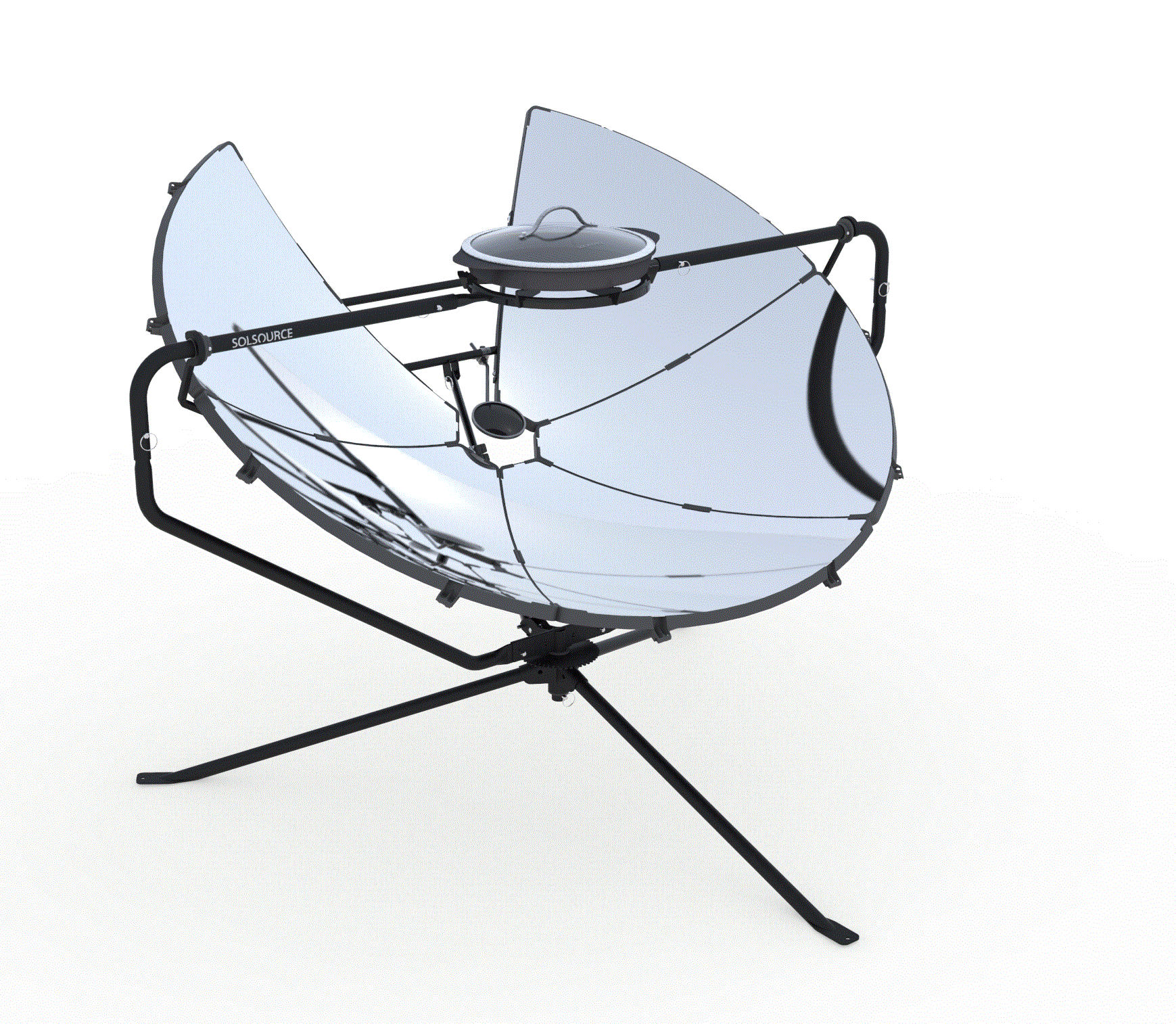 As we mentioned a couple of weeks ago, the good folks at Solavore have loaned us a solar oven to play with this summer. We’re still working on how to cook in the thing–more on that later–but we thought we’d take a moment to show you the oven itself.
As we mentioned a couple of weeks ago, the good folks at Solavore have loaned us a solar oven to play with this summer. We’re still working on how to cook in the thing–more on that later–but we thought we’d take a moment to show you the oven itself.
The basics:
This is a Solavore Sport, which sells from their website for $229.00 US, plus $39.50 for the optional reflector. (We’d recommend the reflector, unless you live near the equator, or only plan to use your oven at midday in high summer.)
Solavore is a woman-run company, based in Minnesota, and the ovens are made the U.S. Plus, Solavore partners with NGOs to bring sun ovens to sun-rich, fuel-poor developing countries.
Solavore keeps an extensive, and attractive recipe section on their site.
The oven itself:
The floor of the oven measures 9 1/4 inches x 17 1/2.
It weighs 9 pounds.
It is entirely made of plastic. The body is all black molded insulated plastic, while the lid is double-walled clear plastic, molded to fit the oven body. There seems to be a trade off going on here between portability (and perhaps lower shipping costs) and structure. They opted for it not to have a heavy casing.
It doesn’t seem flimsy by any means, but at the same time you can imagine doing it some serious damage if you were to trip over it. I worry particularly about cracking the lid around the thin edges. Yet at the same time, I really appreciate the portability. I love how light and easy the Sport is to manipulate. It is simply no big thing to move it around, and until you get the hang of solar cooking, and learn the way the light moves in your yard, you’re going to be moving it a lot. It’s light weight makes it good for camping and picnicking, too.
 The oven is made to hold two cooking pots at a time, which is handy, because you can do a main dish and a side at once, or a pot of something for dinner and a pot of something for lunch.The Solavore comes equipped with two shiny new black Speckleware casserole pots for this purpose, though you may choose to use any pot you like–though lightweight black pots like the Speckleware are best for solar cooking. It’s also big enough hold a casserole dish or a quarter sheet pan.
The oven is made to hold two cooking pots at a time, which is handy, because you can do a main dish and a side at once, or a pot of something for dinner and a pot of something for lunch.The Solavore comes equipped with two shiny new black Speckleware casserole pots for this purpose, though you may choose to use any pot you like–though lightweight black pots like the Speckleware are best for solar cooking. It’s also big enough hold a casserole dish or a quarter sheet pan.
The Solavore also comes with a free standing thermometer which you can use to monitor the internal temperature of the oven.
We don’t have experience with any other commercial sun oven by which to compare the Solavore Sport, so all we can say so far is that it totally works. It’s been getting to cooking temperature easily (200-250F), even though the sun is still a little low in the sky at this time of year, as long as you follow the directions and use it correctly.
 Quibble with the clips
Quibble with the clips
So far we have no complaints at all, and only one quibble: the clips.
The lightweight lid must be clipped down to the oven body to maintain proper heat efficiency. Having failed to read the starting instructions properly (ahem), I missed that detail on our first trial, and had trouble getting the oven up to cooking temp–which lead to a lentil disaster.
I failed to notice the lid clips were there at all first time out because they are not immediately obvious. They are small metal hooks which are permanently affixed through holes in the oven’s body. They come up over the lip of the lid to hold it down tight.
The good thing about these clips is that they are very simple and would be easy to replace with a piece of wire if you break them. Also, since the clips are tied to the oven, they can’t be lost, which is another major advantage.
The downside is that they are finicky to use. I have a hard time getting them over the lip of the lid, and always feel like I’m in danger of abrading or even cracking the edge of the lid as I force them on and off. Each time I wrestle with them, I dream of a quick release system, or wish I could just use binder clips to clamp the lid to the body–but regular clips don’t work because of the particular shape of the lid/body interface.
But all in all, that is, as I say, only a quibble. We’re enjoying playing with the oven, although as I alluded to in my last post on the subject, there is a learning curve to solar cooking. We’ve had a few disasters, which we’ll talk about, but we’re beginning to get a good feel for what works well in this cooking system. More to come soon!




What a great way to eat great and go green! Seems like it’ll need some practice though to have the perfect meal from the start.
So, about $270 for the complete kit – made of thin plastic with wire clips you can likely bend yourself from old leftover hangers.
I think the ‘green’ this company is concerned with has little to do with environmentalism.
We used to get 250 degrees regularly with 2 nested cardboard boxes with shredded newspaper for insultaion and an old storm window on top. This plastic box ain’t worth it- the pots might be handy though.
Thanks–I am going to build a cardboard oven this summer as part of our experiments. Good to know it works so well for you!
I’m excited by your solar cooking experiments — and the recipe resources. Makes me want to borrow a saw, break out the scrap wood and get to work!
Do it! If the saw seems to much, you could make a cardboard stove. As I said in another comment here, I’ll be doing that soon.
Have you any concern about the plastic? Cooking food in a hot plastic box seems iffy to me (but I’m also one of those who bring my own mason jars for bulk….)
I love the idea of supporting a women run company.
Yeah…I don’t like plastic much myself and understand your concern, and I really don’t know what to think. The food is locked up inside the pots, so there’s that.
I’ve had a Solar Oven Society (SOS) Sport oven for many years now. (SOS is where Solavore got the design, according to their website) I had the same reservations about the apparent lack of robustness of the materials, but I have to admit that after a lot of abuse in the “proving grounds” that is my yard, garage, house, and life, this thing has held up without a single broken component.
The reflector isn’t needed in the summer, and care must be taken not to over-heat/burn/melt things, at least here in San Diego county. It gets REALLY hot! Don’t underestimate the heating potential in summer. This time of year, it works better in the other configuration – with the smaller side as the floor, assuming your model works like mine. Of course the pots that came with it don’t fit that way, but smaller, taller ones would. I paid a lot less for mine all those years ago, but I’ve considered it a good investment.
Thanks for the feedback! Yes indeed, this is a close relative–descendant?- of your oven. I’d have to go take a look at it, but I think both sides are the same size in this model. The reflector came with many stern warnings about the possibility of overheating and melting, but with the sun still on the low side, I’ve not seen temps above 250 even with the reflectors on at midday. I’ll be sure to be extra careful as the summer progresses. I’ll also be glad not to fiddle with the reflector anymore. 😉
I looked at the website – you CAN use the back wall (relative to how it is sitting in the 1st pic in the post) as the floor for winter use. They don’t emphasis it, but I always considered it a nice feature, especially for those of us with sunny winters.
As Donna wrote, the Solavore is the same as the SOS sport. I’ve also used mine, multiple times a week, for almost 10 years. Any recipe that works for a slow cooker works with the Solavore – including cornbread, lasagne, etc. I live in Tucson, and don’t need to use the reflectors. And while I appreciate the concern expressed about the cost, I understand that the company supports sending these solar cookers to African countries where lack of fuel is a real problem.
Pingback: Waxed Cloth Food Wrap (Made in a solar oven for bonus self-righteousness points) | Root Simple
When it comes to hacking, people are frequently afraid to download and install things to their
PCs.
We have had a Solar Oven Society sport oven for several years. It works well in the desert, easily reaching 350 degrees. I have used this oven over and over, and love it! I am a baker, and like to use it for baking cakes and bread. It does not brown, but we have gotten used to pale crusted bread!
Just have to remember to start dinner a little early while the sun is high in the sky!
I should add we will in the Sonoran desert, so we have plenty of sun!
I have had sucess with a foil lined box with a layer of plastic wrap over the top as well. When using a box, a bigger box makes a bigger oven!